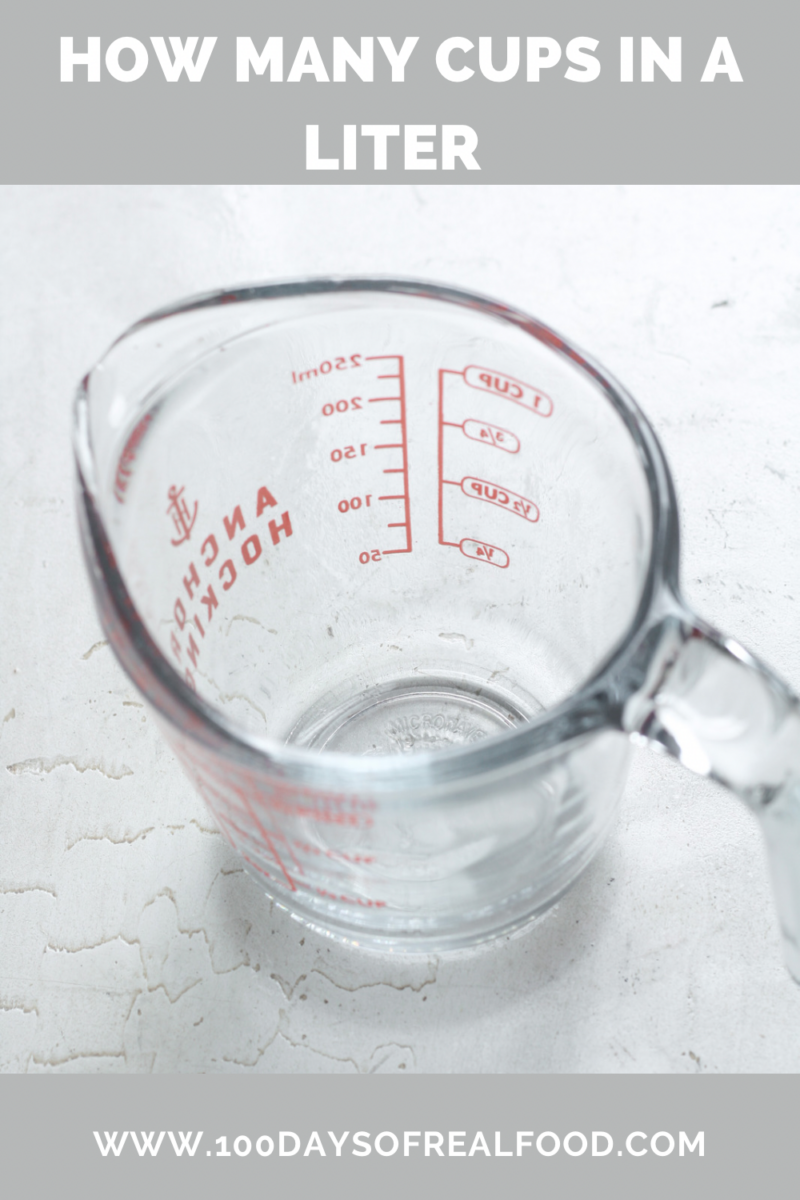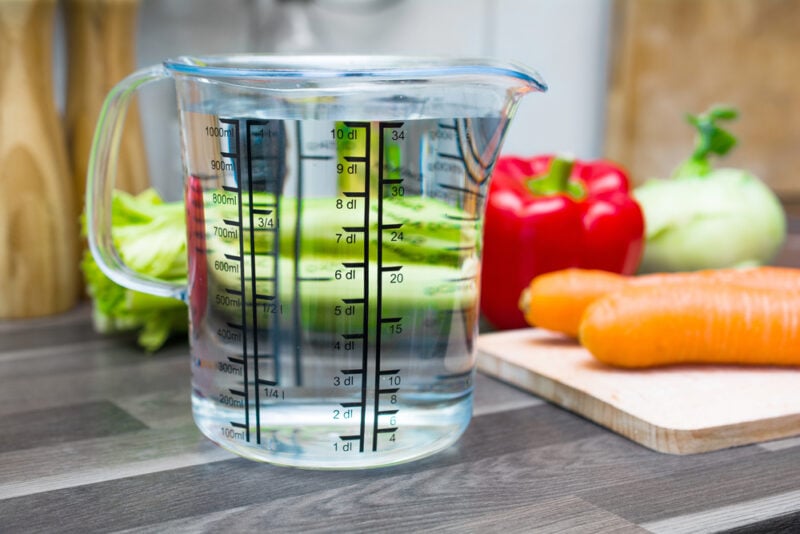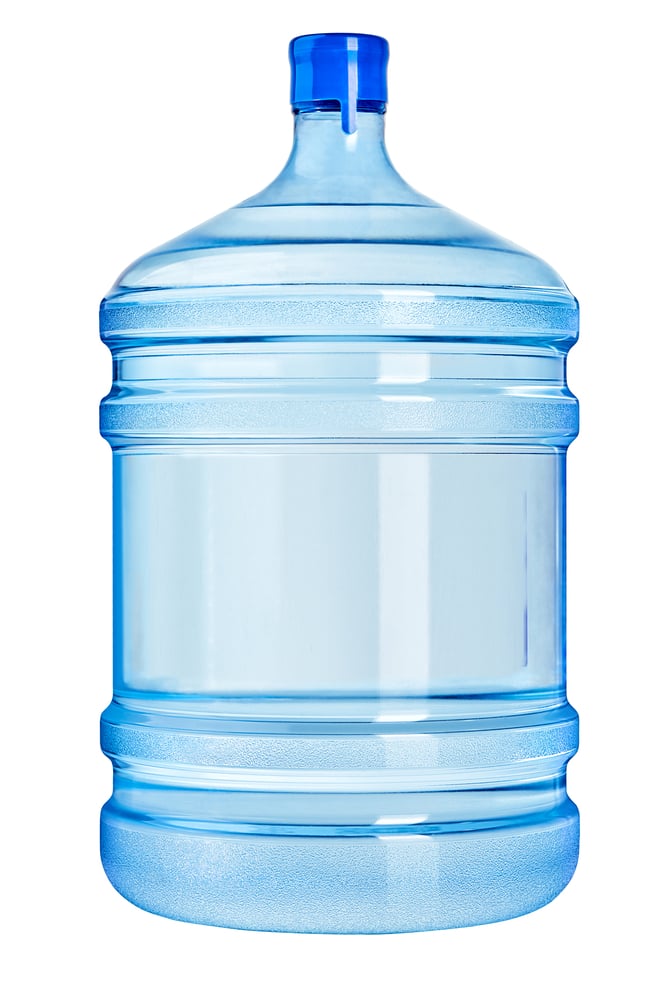[ad_1]
Here is a guideline to determine how many cups in a liter and everything related to measuring with cups and liters.
Understanding how to convert liters to cups and cups to liters is very useful when baking and cooking.
In this post, we share the different ways to measure cups and liters, the tools needed, and more.

What is a Cup?
A cup is a standard way of measuring ingredients in the kitchen. Cups are used to measure wet and dry ingredients. Measuring in cups is incredibly simple.
In the United States, a cup acts as a frequently used unit of volume measurement.
It is often called the “U.S. customary cup.”
When using dry measuring cups, fill them to the brim and then level off the excess with a flat edge of a knife or spatula. To get the most accurate measurement, check that the ingredient aligns with the measurement line at eye level.
When measuring dry ingredients like flour, fluff the ingredient up in the container with a spoon. Then, gently spoon the ingredient into the measuring cup without tapping or shaking it. Level it off with a flat edge for an accurate measurement.
When measuring liquids, pour them into the liquid measuring cup slowly and steadily. Avoid shaking or tapping the cup to ensure the measurement is precise.
What is a Liter?
A liter (spelled as “litre” in some countries) is a unit of volume measurement in the metric system. It is commonly used to measure liquid volumes, but it can also be used to measure certain solids’ volume.
In terms of capacity for liquids, one liter is equal to 1,000 milliliters (mL). In the metric system, the liter is the standard unit for volume.
Use a dedicated liquid measuring cup with liter markings when measuring liquids in liters. These cups are designed to provide accurate measurements for liquids.
Ensure the liquid you are measuring aligns precisely with the desired liter marking on the measuring cup. Lowering yourself to be at eye level with the marking is the best way to get an accurate reading.
Liquids can form a curved surface inside a measuring cup, known as the meniscus. Measure from the bottom of the meniscus for precise readings. The bottom of the curve should align with the measurement line.
The density of different liquids can vary. For example, one liter of water has a mass/weight of 1 kilogram, but the same volume of oil or other substances may have a different mass. This is because their densities are different.
Convert Liters to Cups
1 liter = approximately 4.22675 cups.
Here is how to do this conversion:
- Identify the volume in liters: First, determine the volume you have in liters. This could be the volume of a liquid or any other ingredient you need to measure.
- Multiply by the conversion factor: Multiply the number of liters by the conversion factor of 4.22675 cups per liter.
- Calculate the Result: The result of this multiplication will give you the equivalent volume in cups.
For example, if you have 2 liters of water that you want to convert to cups:
2 liters x 4.22675 cups/liter = approximately 8.4535 cups
So, 2 liters is approximately equal to 8.4535 cups in the kitchen.

Table with Conversions from Liters to Cups
Here is a handy conversion chart to reference for quick answers in the kitchen.
| Liters | Cups (approximate) |
| 1 | 4.22675 |
| 2 | 8.4535 |
| 3 | 12.68025 |
| 4 | 16.907 |
| 5 | 21.13375 |
| 6 | 25.3605 |
| 7 | 29.58725 |
| 8 | 33.814 |
| 9 | 38.04075 |
| 10 | 42.2675 |
Table with Conversions from Cups to Liters
This chart gives the opposite set of information. Print these out and keep them handy in the kitchen.
| Cups | Liters (approximate) |
| 1 | 0.23659 |
| 2 | 0.47318 |
| 3 | 0.70977 |
| 4 | 0.94636 |
| 5 | 1.18295 |
| 6 | 1.41954 |
| 7 | 1.65613 |
| 8 | 1.89272 |
| 9 | 2.12931 |
| 10 | 2.3659 |
Equipment for Measuring
Whether you are a beginner cook or a seasoned chef, having the right tools means your recipes turn out well.
Here are a few tools used for measuring cups and liters:
- Liquid measuring cups. These specialized cups are helpful for accurately measuring liquids, such as water, milk, or cooking oils. Liquid measuring cups come in various sizes, typically ranging from 1 to 4 cups. They have clear markings, often in both cups and milliliters. This helps get precise measurements. The spout allows you to pour liquids smoothly without spilling the ingredients inside.
- Dry measuring cups. When measuring dry ingredients like flour, sugar, or grains, dry measuring cups are super helpful. These cups come in many different sizes, including 1/4 cup, 1/3 cup, 1/2 cup, 1 cup, and more. They have straight edges to assist in leveling off extra or excess ingredients with precision.
- Metric liquid measuring cups. For recipes that use the metric system, metric liquid measuring cups with milliliter markings are fantastic. They let you measure liquids in liters or milliliters. This is useful when working with international recipes or following nutritional guidelines.
- Large pitchers and containers. Large pitchers and containers with liter markings are great when working with larger quantities of liquids, such as when making stocks, soups, or beverages.
- Conversion charts. While not an actual tool, having conversion charts available in your kitchen can be helpful. They will help you determine how many cups in a liter.
Imperial System Versus Metric System
The Imperial measurement system is used in a few countries, including the United States, Liberia, and Myanmar. It weighs ingredients with pounds and ounces to measure larger quantities of flour, sugar, and meat.
Regarding volume measurements, the Imperial system uses fluid ounces, pints, quarts, and gallons, mainly for liquids like milk, oil, water, etc.
The Fahrenheit scale from the Imperial system is used for cooking and baking temperatures.
The Metric system is the global standard for measurement. In the kitchen, grams are the main way of measuring weight. This system is precise but not as easy-going as the Imperial Systems’ measurements and tools.
Milliliters are the metric system’s choice for liquid measurements.
The Celsius scale is the Metric system’s choice for temperature measurement.
Frequently Asked Questions (FAQs):
There are approximately 4.22675 cups in a liter.
One cup is approximately equal to 0.23659 liters.
The number of cups in a liter of butter would depend on the density and consistency of the butter. 1 liter of butter would be roughly equivalent to approximately 4.22675 cups.
There are about 4.22675 cups in a liter of water.
The number of cups in a liter of flour depends on the type of flour and how it is packed. On average, 1 liter of all-purpose flour is about 4.22675 cups.
Cups can be measured using standard dry measuring cups, liquid measuring cups, and adjustable measuring cups. Using the appropriate cup type for the ingredient you’re measuring is essential.
Liters can be measured using graduated containers and liquid measuring jugs with liter markings.

You May Also Enjoy
If you enjoyed this how many cups in a liter post, please leave a rating and comment! For more inspiration, check out my Facebook, Instagram, and Pinterest. For 5 free weekly meal plans and more free resources, sign up to receive my free newsletter!
Enjoy this comprehensive guide for converting cups to liters!
[ad_2]
Source link

